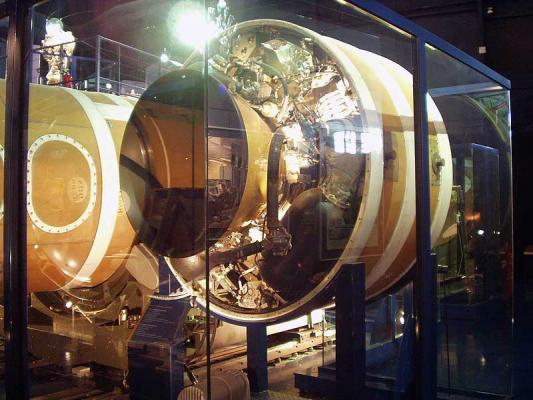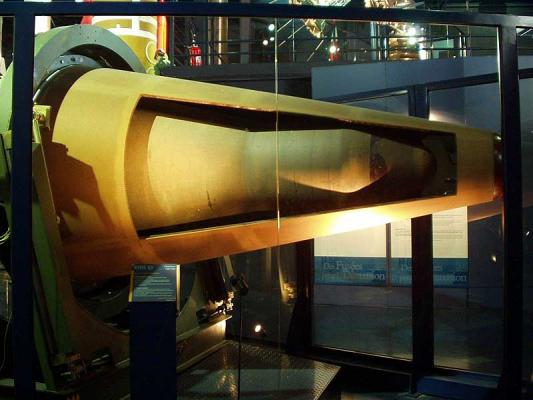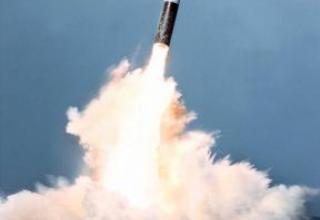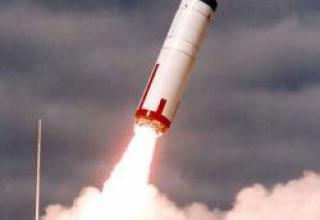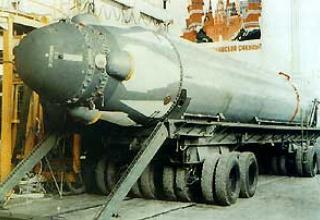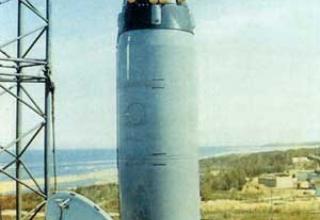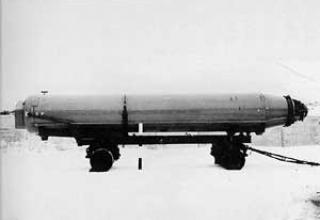
The practical development of a nuclear submarine project in France began in 1958, when the first nuclear submarine was laid at the state shipyard in Cherbourg. However, a year later, due to difficulties encountered in building a nuclear reactor for the main power plant, the construction of the submarine was temporarily suspended. A significant amount of additional research work was required. Eventually, the design of the first nuclear submarine was taken out of construction. Later, the hull was used for the new but already experimental diesel-electric submarine "Le Gymnote", designed to test the systems of future SSBNs, as well as for flight testing of ballistic missiles. It was equipped with four mine launchers, which were converted to test new SLBMs. The first setbacks caused some hesitation in the minds of the French military about the way forward in building a strategic nuclear force. The final decision to develop a sea-based missile and nuclear weapon system was taken only in 1963. The development of the maritime nuclear missile force was carried out jointly by the CEA Commissariat for Atomic Energy, the DEN's Missile Directorate and the DCN's Coelacanthe Naval Construction Directorate. The French Ocean Strategic Forces FOST was officially formed in 1967.
By the time the official decision to create a SLBM was made, French missile builders had already accumulated some experience in building small solid-fuel missiles that were being tested at the Hammagir test site in Algeria (the site was code-named "Gems"). It was decided to maximize the integration of the French SLBM and MRBM programmes. In order to create the first French strategic missiles, the French National Ballistic and Aerodynamic Research Laboratory was established under the auspices of the state organization sEREB (Organization for Research and Development of Ballistic Missiles). The efforts of the leading French aerospace companies of that time, first of all "Aerospace", "Norde Aviación" and "Zude Aviación", were combined. The combat unit was designed and manufactured by the CEA, the civil commissariat for nuclear energy. Successes in the field of rocket engineering, achieved by French scientists and designers in the second half of the 60's, allowed to create a prototype of the first own SLBM, designated M112 and tested at Hammagir and Ile du Levant (complexes Nemo and Brigitte, respectively) by 1966. In 1967, testing of this missile began with the "Le Gymnote" submarine. This success was a strong incentive to maximize the construction of French SSBNs: the second Five-Year National Armed Forces Development Plan (1966-1970) provided funding for the construction of three missile carriers. However, the plans were soon noticeably expanded - in 1967, the Ministry of Defense officially announced its decision to build a fourth nuclear missile boat, and in 1971 (when the first SSBNs were added to the fleet) a fifth. The five SSBNs planned to be built within ten years were to be equipped with more advanced missiles as they became operational.
The first national SSBN - "Le Redoutable" was introduced into the fleet in 1971, and in 1972 entered the ocean for combat patrols. The second submarine in the "Le Terrible" class was handed over to the Navy in 1973 and at the same time entered the first combat patrol. The first French SLBM was the M1 SLBM, which entered service in 1971. This missile was a two-stage solid propellant rocket with sequential connection of stages and a monoblock nuclear HC MR-41 with a power of 0.5Mt. The range of missiles, according to published data, was 2600 km at the KVO 3.2 km.
However, the third SSBN - "Le Foudroyant", which joined the fleet in 1974, was equipped with more advanced M2 SLBMs, adopted for service in 1974. The new missile differed from the M1 by a modified second marching stage and improved inertial control system, which allowed to increase the range up to 3000 km while reducing the CVO to 2km. According to some data, two SSBNs equipped with M1 were also adapted for the new SLBM.
However, the qualitative increase in the attack power of French SSBNs occurred with the adoption of the M20 SLBMs in 1976. When designing the new SLBM, the designers were tasked with improving all characteristics - range and accuracy, as well as RF power. It was planned to equip the missile and the missile defense system - this decision was largely motivated by the significant successes achieved by the U.S. and the Soviet Union in the creation of missile defense (ABM). The economic situation in France in the late 60's - early 70's was difficult, so in addition to the above tasks, the designers were tasked with the maximum unification of the new SLBM both with the M2 missile already in service, and with the emerging promising S3 MRBM. The new missile was to receive the TN-60 thermonuclear HF with the power of 1.2 Mt.
The first serial TN-60 HF was handed over to the military in January 1976. However, this HC was not in service for long - in 1977, the first serial improved TN-61 HC was released, which differed from its predecessor by reduced weight and increased resistance to fossil fuels. The M20 SLBM entered service first of all with two new SSBNs - "L'Indomptable" (in service since 1976, first combat patrol in 1977) and "Le Tonnant" (in service since 1980, first combat patrol in 1980). The previously operational submarines were upgraded to a new missile system in 1977-1979. Thus, by 1981, the French Maritime Strategic Nuclear Forces had five identical SSBNs equipped with the M20 system. However, despite the sharp increase in the capabilities of French SSBNs, they were still much inferior to modern American and Soviet SSBNs.
The next stage of French SSBNs development began in 1985 with the entry into service of the sixth SSBNs and the adoption of a new M4 family of SSBNs. The process of modernization of previously released submarines and equipping them with new missiles began immediately. All modified submarines went into service between 1987 and 1993. It was decided not to rearm the first submarine in the class - Le Redoutable - in the new geopolitical conditions (the end of the Cold War, etc.), and by the end of 1991 it was withdrawn from the fleet, and the missile system M20 - the last French complex with SLBMs of the first generation - was at the same time withdrawn from service.
Composition:
The rocket (see the layout diagram) was designed in a two-stage scheme with sequential arrangement of degrees. The casing of the first stage of the SEP 904 missile was made of special light and heat-resistant steel Z2-NKTD. The stage casing was coated with a special advanced heat-protective coating of light type, which protected the missile from aerodynamic heating and the effects of PSNF. To create control forces to control the missile in the active section of the trajectory on pitch, roll and yaw on the first degree, four tilting nozzles of high strength and heat-resistant alloy were used. The stage was unified to the maximum extent possible with the first march stage of M1 and M2 SLBMs.
The case of the second marching step Rita-2 has been executed from a light and high-strength organic material (glass fibre) by a method of winding of threads. The stage body was covered with a special advanced heat protection coating of light type. The second stage rocket motor had one central fixed recessed nozzle. In order to control the traction vector in the second stage through the channels of pitch and yaw liquid freon was injected from a special tank, placed in the second stage, into the critical part of the nozzle. The heel was controlled by an autonomous gas generator system with fixed control nozzles. The use of new fuel allowed for a higher specific impulse. The second stage was maximally unified with the second marching stage of the French MRSD S3.
Each stage was equipped with a system of forced liquidation in case of flight program violation. A way of division of marching steps - cold mortar, at the expense of supercharging of interstage space by means of the special gas generator and cross division of connection of steps by means of the extended conic charge. The way of separation of a head-end from the second marching step after an exit on a demanded ballistic trajectory was traditional for ballistic missiles - separation of a head-end from the second degree by means of operation of pyrolocks, and then opening of counteraction nozzles on the second stage that stopped burning of the marching engine, braked a step and led it away from the separated head-end.
In contrast to its predecessors, the new missile had a new thermonuclear monoblock HF, covered by a large portion of the active flight area of the head fairing. The head cowl was maximally unified with the MRBM S3 head cowl. The TN-61 thermonuclear monoblock HC had significantly higher power (1.2 Mt) and resistance to PFBLs than the MR-41 HC of M1 and M2 missiles, as well as increased safety during transportation and storage. The new combat unit was more high-speed, had less dispersion in the atmospheric section of the trajectory and greater resistance to fossil fuels. According to a number of data, it was covered with a special radio absorbent coating and contained equipment to create radio interferences with the working missile defense radars of the probable enemy. The combat unit was equipped with ablative-type thermal protection. The combat unit had air and contact blast options. The missile carried a complex of means of overcoming (SLC) ABM, which consisted of light false targets and dipole reflectors, placed in special containers installed on the second stage of the missile - for the first time in the French ballistic missiles. The mass of the HC and SLCM ABM was 1 ton. Initially (1976-1977) some missiles were equipped with a monoblock HC TN-60 - the first French thermonuclear device that entered into service. This HC differed from TN-61 in that it was more mass and less resistant to foammable substances. By 1978 all TN-60s were brought to the TN-61 level.
The M20 missile was equipped with a new French-made inertial control system with a block of high-speed gyroscopes and BCVM, located in a special instrument compartment as part of the second stage. The control system had an increased resistance to fossil fuels. The maximum range (3200 km with the TN-61 BC) was 1 km. The missile could fire on one of several (a number of data, 4) predetermined target designation (data stored in the BCVM), which significantly expanded the combat capabilities of the complex compared to its predecessors.
The M20 SLBMs are designed to be launched from a submarine at depths up to 30 m. The first missile could be prepared for launch in a time period of 30 to 20 minutes, depending on the level of electronics (which was upgraded to reduce the pre-launch preparation time) and the subsequent ones in a time period of 1 minute to 30 seconds. The rockets from the launchers are fired by steam-gas. The walls of the launch glass have several rows of obturation rings, and from above it is covered with a dome membrane made of phenolic resin reinforced with asbestos. The vapour mixture required to eject the missile from the mine is produced by the PADs. The gases they generate first pass through a water tank (cooling chamber), mix with it in certain proportions and form low-temperature steam. This steam enters the chamber formed by the skimmer of the rocket and the bottom of the mine.
On the Le Redoutable-class SSBNs, all 16 SLBMs are placed in two rows of launchers in the same compartment. According to a number of data, French SSBNs also possess and have the capability to launch their missiles from an above-water position, including a basing point. The automated combat control system installed on the SSBNs provides automatic monitoring of the state of the missiles in the ABI, preparing them for launch, redirection if necessary and launch.
Characteristics:
| Range of fire, km | 3200 |
| KVO, m | 1000 |
| Length assembled with HF, m. | 10.4 |
| Diameter of the case maximum, m | 1.5 |
| Start mass, t | 19.95 |
| Masses of BC and SSB missile defense, t | 1 |
| BC power, Mt. | 1.2 |
| 1st stage engine traction at sea level, kN | 444.2 |
| Weight of fuel RDTT 1st stage, t | 10 |
| RDTT 1st stage charge burning time, s | 55 |
| 2nd stage motor traction in vacuum, kN | 313.8 |
| Mass of fuel RDTT 2nd stage, t | 6 |
| RDTT 2nd stage charge burning time, s | 58 |
Testing:
Terms of development of the M-1 complex were ahead of the terms of delivery of the head ship at Prospect 61 of Plant № 1701 (SKR-25 from 9.10.62 "Komsomolets of Ukraine") - so the Order of the USSR CM № 2110 of 30.07.1959. joint tests of M-1 were transferred to the rocket ship "Bravy" pr.56K. Tests on "Bravo" were held in two stages - from 5.01.62 to 12.03.62 and from 12.03.62 to 30.04.62. During the tests it was noted that the time of "Yatagan" exit from the cold position was 5 minutes, the range of "Yatagan" escorting the target was 42 km with a 50% probability of capture and 36 km with a probability of 80%. The missile's range was 15 km, and the self-destruct time was 26 seconds.
During the tests of the complex was shot down six target aircraft MiG-15M, flying at an altitude of 0.6 to 10 km, with missiles missed from 9 to 48 meters. According to the commission, the probability of hitting the aircraft at a miss of 20 meters is 0.9, while at a miss of 40 meters - 0.4-0.6. The M-1 complex could hit targets flying at a speed of up to 600 meters per second. The target can maneuver at altitudes up to 4 km with an overload of 3 - 4 g, and at high altitudes - up to 2 - 3 g. The speed of the ship during launches can be up to 36 knots. There was no firing from Bravoi on surface targets.
According to the results of tests on "Bravoi" the M-1 SAM system was recommended for adoption for service.
Sources:
- www.netmarine.net
- www.capcomespace.net
- www.nuclearweaponarchive.org
- www.globalsecurity.org
- www.space.eads.net
- www.dcnsgroup.com
- www.arms.ru
- www.ship.bsu.by
- www.warships.ru
- Национальная оборона, 2006, №4.
- Ю.В.Апальков, Д.И.Мант, С.Д.Мант "Отечественные баллистические ракеты морского базирования и их носители", 2006 г.
- Широкорад А.Б. «Атомный таран XX века», Москва, «Вече», 2005.
- Ю.И.Александров, А.Н.Гусев. Боевые корабли мира на рубеже XX-XXI веков. Санкт-Петербург, изд-во «Галлея Принт», 2000.
- Twenty-first century submarines and warships / The Brown reference group plc. London, UK. 2004
- Dossier de presentation des essais nucleaires et leur suivi au Sahara. Delegation a l’Information et a la Communication de la Defense / Ministere de la Defense. Paris, France. 2007

